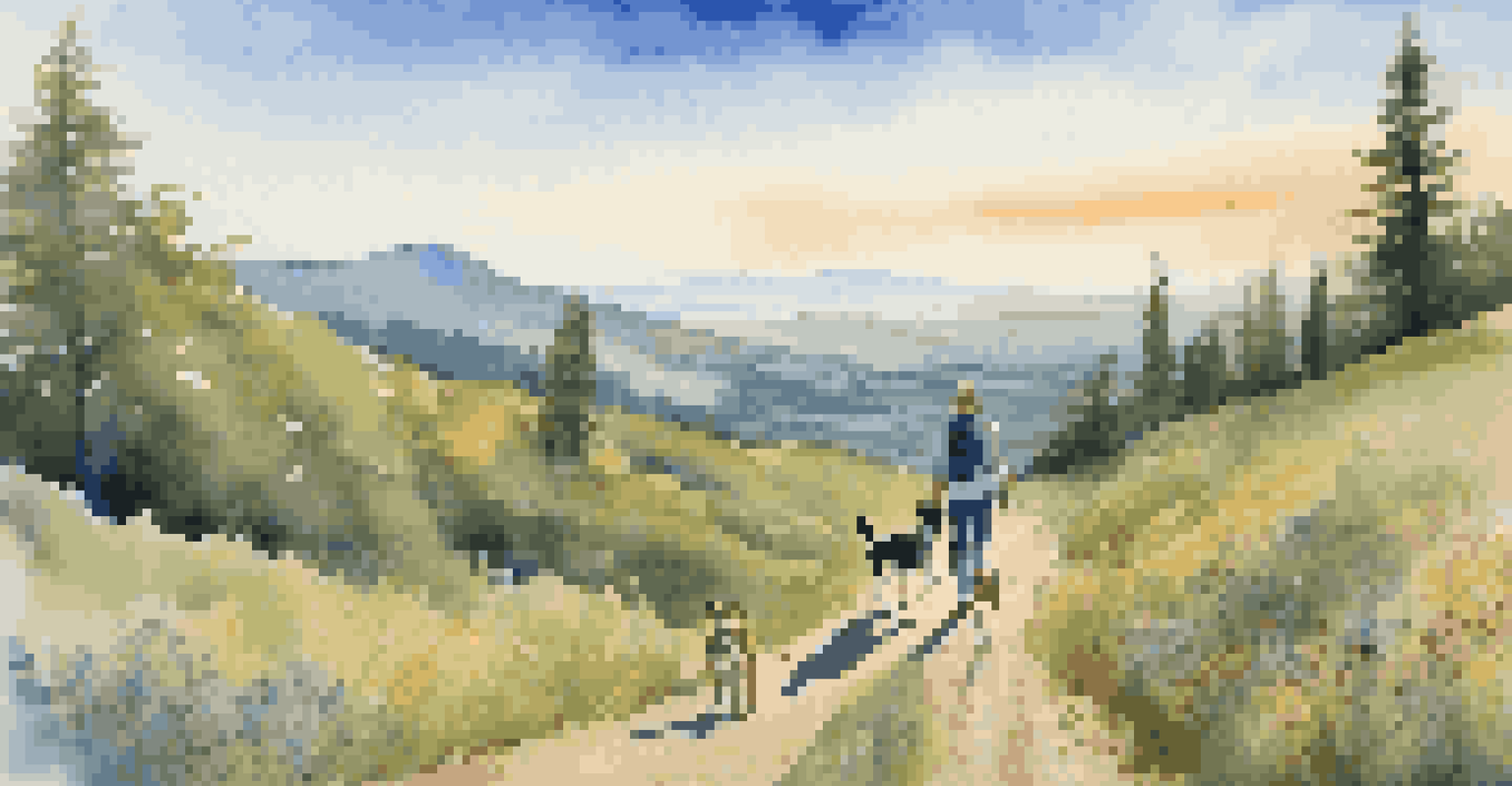Camping with Pets: Guidelines for an Outdoor Adventure

Choosing the Right Campsite for You and Your Pet
When planning a camping trip with your pet, selecting the right campsite is crucial. Look for pet-friendly locations that allow animals and have the necessary amenities. Researching beforehand can help you avoid surprises, such as restricted areas or lack of water sources.
In every walk with nature, one receives far more than he seeks.
Consider the terrain and environment of your chosen site. Some pets may thrive in open fields, while others may prefer wooded areas for shade and exploration. It's essential to match your pet's comfort level with the campsite’s conditions to ensure both of you have a great time.
Lastly, check the campsite’s rules regarding pets, including leash laws and waste disposal. By being informed, you can maintain a harmonious relationship with fellow campers and ensure your pet's safety throughout the adventure.
Packing Essentials for Your Pet’s Comfort
Packing for your pet is just as important as packing for yourself. Start with the basics: food, water, bowls, and a leash. Don’t forget any medications your pet may need and a first aid kit specifically for your furry friend.

Consider bringing along some familiar items, like your pet's favorite blanket or bed. This can help them adjust to the new environment and feel more at home. A few toys can also keep them entertained during downtime at the campsite.
Choose Pet-Friendly Campsites
Researching campsites in advance ensures you find pet-friendly locations with the necessary amenities for a smooth camping trip.
Remember, the more prepared you are, the smoother your trip will go. By ensuring your pet has everything they need, you can focus on enjoying the great outdoors together.
Safety Tips for Outdoor Adventures with Pets
Safety should always be a top priority when camping with pets. Always keep your pet on a leash to prevent them from wandering off or encountering wildlife. This not only protects them but also ensures the safety of other campers and animals.
The greatness of a nation and its moral progress can be judged by the way its animals are treated.
Be aware of potential hazards in the area, such as poisonous plants or dangerous insects. Familiarizing yourself with local wildlife can also help you understand what to watch out for, from snakes to bears, depending on where you’re camping.
Lastly, make sure your pet is wearing a collar with an ID tag that includes your contact information. In case of an emergency or if they get lost, this simple step can make all the difference in reuniting you with your furry companion.
Understanding Local Wildlife and Your Pet
When camping, it's essential to understand the local wildlife and how your pet might react to it. Some pets may be curious, while others might be fearful or anxious. Observing how your pet behaves in different scenarios can help you prepare for interactions with wildlife.
Keep in mind that some animals may pose a threat to your pet. For example, encounters with snakes or larger mammals like bears can be dangerous. Researching the area beforehand can equip you with knowledge on how to keep your pet safe from such encounters.
Pack for Your Pet's Comfort
Bringing familiar items and essentials for your pet can help them feel at home and ensure their comfort during your outdoor adventures.
Additionally, consider your pet's instincts and behaviors. If your dog loves to chase, keeping them on a leash can prevent them from running into potentially dangerous situations. Staying vigilant is key to ensuring a safe camping experience.
Establishing a Routine While Camping
Pets thrive on routine, and camping is no exception. Establish a daily schedule for feeding, walks, and playtime to maintain a sense of normalcy for your pet. This helps reduce any anxiety they may feel in the new environment.
Incorporating regular breaks during hikes or outdoor activities ensures that your pet stays hydrated and rested. Plan short, frequent stops to allow them to explore and relieve themselves, making the experience enjoyable for both of you.
By sticking to a routine, you not only keep your pet comfortable but also enhance your overall camping experience. It creates a sense of stability amid the adventure, making it easier to manage your time together.
Cleaning Up After Your Pet: Best Practices
Being a responsible pet owner means cleaning up after your pet during your camping trip. Always carry biodegradable waste bags to dispose of your pet’s waste properly. This courtesy keeps the campsite clean and pleasant for everyone.
Designate a specific area for your pet to do their business, away from trails and water sources. This not only minimizes mess but also helps protect the environment and wildlife.
Prioritize Safety and Emergencies
Keeping your pet safe involves understanding local wildlife, following safety protocols, and being prepared for emergencies with a first-aid kit.
Remember, leaving no trace is essential in nature. By respecting the environment and other campers, you set a positive example and ensure that everyone can enjoy the beauty of the outdoors.
Preparing for Emergencies on Your Camping Trip
Emergencies can happen, so it's best to be prepared. Familiarize yourself with the nearest veterinary services, just in case your pet needs medical attention during your trip. Having a plan can ease your mind and ensure you’re ready for anything.
Create a pet-first-aid kit that includes essentials like bandages, antiseptic wipes, and any medications your pet may need. Knowing how to handle minor injuries can make a significant difference in your pet's comfort and safety.

Lastly, keep a close eye on your pet for any signs of distress or illness. Early detection can often prevent more serious issues, allowing you both to enjoy your outdoor adventure without worry.